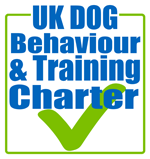If you want a well-behaved dog, you need to start training as soon as you can. This means that with puppies it’s from the very first day you get them home. Start gently with potty training as this will save you lots of cleaning up, then in the following days start to drip feed your training. Getting a new puppy is exciting but remember to not overwhelm your dog as there will be so many changes in its life, go easy, especially at the beginning.
What are the benefits of training my dog?
Dogs are exceptionally intelligent and can easily get bored so keeping their mind active is an excellent outlet for them as well as physical exercise. Not only do dogs love to learn, but it is also a pleasure having an obedient dog you can take with you anywhere and have guests come and visit you without you feeling embarrassed. The benefit of training good behaviours from day one is well worth it.
Use positive reinforcement
When training your dog it is important to correct behaviour in a kind and ethical way. This means that you are responsible for managing your new puppy’s environment so they don’t pick up the shoes you left or didn’t let them out often enough and they toileted in the house. Use plenty of positive reinforcement for good behaviour and teaching basic commands. Your dog will love training with you and learn very quickly and training dogs will come second nature to you.
Training dog’s with basic commands will benefit the training process overall and help prevent behaviour problems later on.
Is it ever too late to start training a dog?
Whether a dog is young or old, they can always learn new things. You can’t teach an old dog new tricks is definitely an old wives tale! You can start with teaching the basics at home and build up your dog’s vocabulary.
7 basic dog commands to teach your dog
Sit Down Come Stay ·Leave it ·Fetch Drop
If you need some help with training you can either enrol in some dog training classes or an online qualified dog trainer. A dog trainer will be able to help you with teaching your dog to ‘do’ things such as walk nicely on the lead, recall and other dog sports for example whereas a qualified dog behaviourist specialises in behavioural issues such as excessive barking, aggression, destructiveness, fear, anxiety and phobias.
How do dogs learn?
Dogs learn by association or consequence and the easiest way to start is by finding out what motivates them. It is important to find out what your dog really likes and what their favourite things are so that you can use them as rewards in training. Remember each dog will be different. By giving your dog what they really like such as food, toys, praise or an activity such as running, your dog will me more likely to do a particular behaviour again. Remember when you are using food, make sure your training treats are small.
How to train your dog
Always start your training session in a quiet room without distractions. Its easier to teach a dog a new trick or behaviour when they are somewhere they feel comfortable and are not distracted. Then once they have learnt the behaviours you can then practice them in other places outside the home environment.
Always keep your training sessions short, fun and try and do them regularly throughout the day so your dog isn’t overwhelmed or frustrated. You will need to be patient as some dogs learn quicker than others so don’t worry if your dog doesn’t get things straight away. It is ok to give your dog a treat after each thing you ask of them.
The key is to always keep them motivated to learn
Make sure your dog is always motivated and most importantly that both of you are enjoying it! Games based training can be extremely helpful as we all know it is easier to learn when you are having a good time.
Clicker training for dogs
We would always recommend using reward based training to train a dog. There are many different types of positive reinforcement training but clicker training is a common form of positive reinforcement. Using a marker such as a click can be a simple yet highly effective dog training method where, if used correctly, can see very quick results so good for both the dog and owner.
Lead (or Leash) Training
This can be the part of training that your pup finds the hardest as leash training is very repetitive. We would recommend going to a dog training class or getting some online 1:1 sessions so you can get this right. There is a technique to leash walking the invaluable training tips you will get from a trainer will fastrack training your dog.
Use plenty of positive reinforcement when your dog is walking nicely and when they start to pull, change direction as you give your cue of ‘this way’ or ‘with me’. Building engagement is key for this part of your dog’s training.
Teaching your dog a reliable recall
Do you have a reliable recall of your dog? Or do they choose not to listen? Are you too scared to let them off the lead?
The BEST way to teach your dog to come back every time you call them is if you teach them 15 games to come back to you. This keeps training fun and never boring for your pup.
Everyone knows the standard ‘come’ or ‘here’. However, this gets really dull for a dog especially when there are lots of distractions.
Here is one example of something else you can do to call them back:
Having a recall hierarchy
A magic word – ‘Sausages!!’
First, you will need to condition a word indoors for this exercise. For your dog, this magic word will = a jackpot of treats. Yum, yum!
For this cue use a word like ‘Sausages!’, ‘Squirrels!’ or ‘Sweeties!’ and use an excited tone of voice. Say your cue and when your dog looks up at you, drop 5-10 treats onto the ground by your feet. Repeat this (indoors only) 5 times a day for 7 days.
By now the dog will think this word is amazing!
Why teaching tricks is good for your dog
Teaching your dog tricks may seem meaningless at first but it is actually an essential part of learning.
It creates a great building platform for more complex tasks in many respects. Here are just a few examples of why trick training should be part of your routine:
Education Physical exercise Mental exercise Core strength Low impact training Body awareness and coordination Conceptual learning
House training and crate training for dogs
House training can also sometimes be called housebreaking or potty training and this is where you teach your dog to toilet outside or in a designated place. Using a crate for your dog to sleep in at night can really help speed up house training as you can take them straight out into the garden as soon as they wake up.
Dogs generally don’t want to soil in their own bed if they can avoid it so would let you know by barking or whining that they need to get up and go to the toilet. You may also leave a dog safe toy in the crate to keep them occupied and happy. Never put them in the crate as a punishment or leave them in there if they are distressed.
Contact Us
Get in touch for a FREE 20 minute telephone or video call about how we can help your dog. It’s the ideal opportunity for you to get to know us, discuss your specific training needs and for us to explain how we can help.
Telephone: 07557 301161






